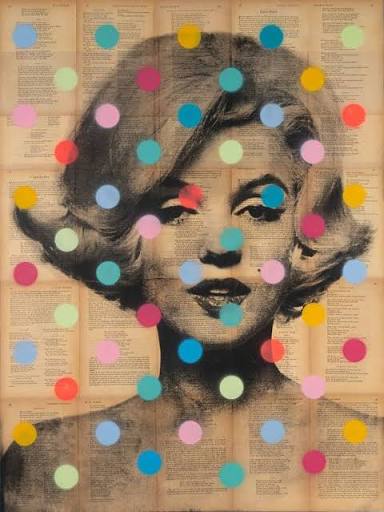Dane Shue’s “Marilyn Monroe” is a striking acrylic painting created in the year2000, encapsulating the essence of one of Hollywood’s most enduring icons. This artwork stands as a testament to Shue’s ability to merge pop art sensibilities with a modern, dynamic aesthetic, creating a piece that is both visually arresting and deeply evocative. The painting is a celebration of Marilyn Monroe’s timeless allure, while also showcasing Shue’s technical prowess and innovative approach to portraiture.
The Artist
Dane Shue is an accomplished contemporary artist known for his vibrant, expressive works that often draw inspiration from popular culture, music, and iconic figures. His style is characterized by bold colors, energetic brushstrokes, and a keen sense of composition. Shue’s ability to capture the essence of his subjects while infusing them with a modern twist has earned him a dedicated following in the art world.Born and raised in the United States, Shue’s artistic journey has been shaped by his fascination with the interplay between art and culture. His works often reflect a deep appreciation for the icons of the 20th century, reimagining them through a contemporary lens. “Marilyn Monroe” is a prime example of this approach, blending the nostalgia of Monroe’s legacy with the freshness of Shue’s artistic vision.
The Subject
Marilyn Monroe, born Norma Jeane Mortenson in1926, remains one of the most iconic figures in American pop culture. Her career as an actress, model, and singer catapulted her to global fame, and her image has become synonymous with glamour, beauty, and vulnerability. Monroe’s life, marked by both triumph and tragedy, has made her a subject of endless fascination for artists, writers, and filmmakers.
In Shue’s painting, Monroe is depicted in a way that captures her dual nature—her radiant public persona and the underlying complexity of her private life. The artist’s choice of Monroe as a subject reflects her enduring cultural significance and her ability to resonate with audiences across generations.
The Painting: Composition and Technique
Shue’s “Marilyn Monroe” is a masterful example of acrylic painting, a medium known for its versatility and vibrant color potential. The painting measures [insert dimensions if available], making it a substantial and impressionable piece. The composition centers on Monroe’s face, rendered with a combination of realism and abstraction that draws the viewer’s eye to her expressive features.
Color Palette
The color palette of the painting is bold and dynamic, with Shue using contrasting hues to create a sense of depth and movement. Warm tones, such as reds, oranges, and yellows, dominate the piece, evoking Monroe’s warmth and vitality. These are juxtaposed with cooler shades of blue and purple, which add a layer of complexity and introspection to the portrait. The interplay of colors not only highlights Monroe’s physical beauty but also hints at the emotional depth beneath her glamorous exterior.
Brushwork and Texture
Shue’s brushwork is loose and expressive, giving the painting a sense of energy and spontaneity. The artist employs a variety of techniques, from broad, sweeping strokes to finer, more detailed lines, to create texture and dimension. This approach lends the piece a tactile quality, inviting the viewer to engage with it on a sensory level. The texture of the acrylic paint itself adds to the overall effect, with layers of color building up to create a rich, almost sculptural surface.
Facial Expression and Pose
Monroe’s face is the focal point of the painting, and Shue captures her likeness with remarkable accuracy. Her signature features—the soft curve of her lips, the arch of her eyebrows, and the sparkle in her eyes—are rendered with a blend of precision and artistic flair. The pose is classic Monroe, with her head slightly tilted and her gaze directed outward, exuding confidence and allure. At the same time, there is a hint of vulnerability in her expression, a reminder of the complexity that lay beneath her public persona.
Themes and Interpretation
Shue’s “Marilyn Monroe” can be interpreted on multiple levels, reflecting both the subject’s cultural significance and the artist’s personal vision.
Celebration of Iconic Beauty
On one level, the painting is a celebration of Monroe’s iconic beauty and her status as a cultural symbol. Shue’s vibrant colors and dynamic composition emphasize her radiance and charisma, capturing the essence of what made her a star. The painting serves as a tribute to Monroe’s enduring legacy, reminding viewers of her impact on popular culture.
Exploration of Identity
At the same time, the painting invites a deeper exploration of Monroe’s identity and the duality of her life. The interplay of warm and cool tones, as well as the combination of realism and abstraction, suggests the contrast between her public image and her private struggles. Shue’s portrayal hints at the complexity of Monroe’s persona, encouraging viewers to look beyond the surface and consider the woman behind the icon.
Reflection on Fame and Legacy
The painting also serves as a reflection on the nature of fame and the ways in which cultural icons are remembered and reinterpreted. By depicting Monroe in a contemporary style, Shue bridges the gap between past and present, highlighting her continued relevance in the modern world. The piece raises questions about the construction of celebrity and the ways in which figures like Monroe are immortalized in art and popular culture.
Artistic Influences and Context
Shue’s “Marilyn Monroe” is deeply rooted in the tradition of pop art, a movement that emerged in the mid-20th century and sought to blur the boundaries between high art and popular culture. Artists like Andy Warhol, Roy Lichtenstein, and James Rosenquist were instrumental in shaping this movement, and their influence can be seen in Shue’s work.Warhol’s iconic silkscreen portraits of Monroe, in particular, serve as a clear point of reference for Shue’s painting.
However, while Warhol’s works emphasize repetition and mass production, Shue’s approach is more personal and expressive. His use of acrylic paint and bold brushstrokes gives the piece a sense of individuality and immediacy, setting it apart from the more mechanical aesthetic of classic pop art.
Reception and Legacy
Since its creation in2000, Shue’s Marilyn Monroe has garnered acclaim for its innovative approach to portraiture and its powerful evocation of Monroe’s legacy. The painting has been exhibited in galleries and art shows, where it has captivated audiences with its vibrant colors and emotional depth. For collectors and art enthusiasts, the piece represents a unique fusion of traditional and contemporary elements, making it a valuable addition to any collection. Its exploration of themes like identity, fame, and cultural memory ensures its continued relevance in the world of art.
Impression
Dane Shue’s Marilyn Monroe is a masterpiece of contemporary acrylic painting, blending technical skill with a profound understanding of its subject. Through his bold use of color, expressive brushwork, and thoughtful composition, Shue captures the essence of Monroe’s iconic beauty while also exploring the complexity of her identity.
The painting stands as a testament to Monroe’s enduring legacy and Shue’s artistic vision, offering viewers a fresh perspective on a cultural icon.In a world where the lines between art and popular culture continue to blur, Shue’s work serves as a reminder of the power of portraiture to transcend time and connect us with the figures who shape our collective imagination.
Marilyn Monroe is not just a painting; it is a celebration of an icon, a reflection on fame, and a testament to the enduring allure of one of Hollywood’s brightest stars.
No comments yet.








